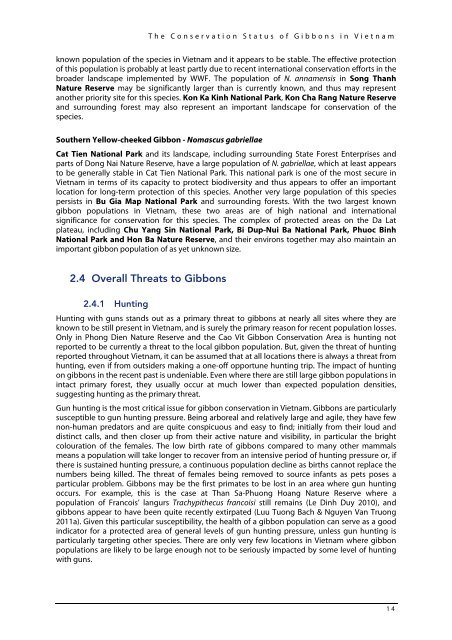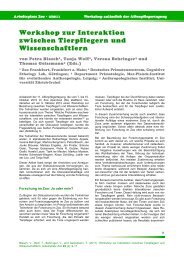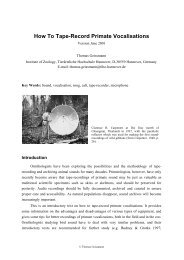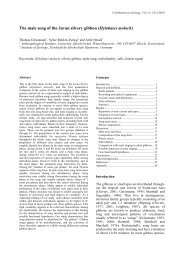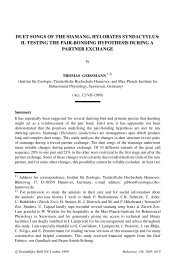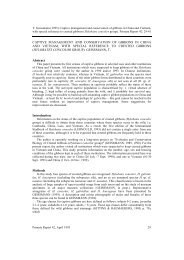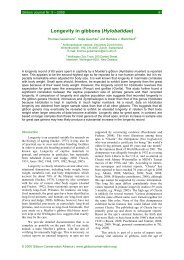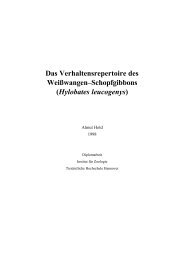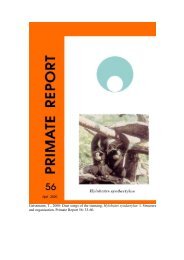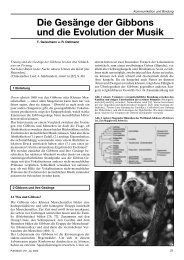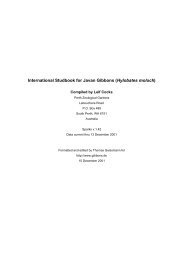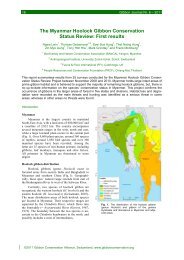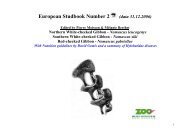<strong>The</strong> <strong>Conservation</strong> <strong>Status</strong> <strong>of</strong> <strong><strong>Gibbon</strong>s</strong> <strong>in</strong> <strong>Vietnam</strong>known population <strong>of</strong> the species <strong>in</strong> <strong>Vietnam</strong> and it appears to be stable. <strong>The</strong> effective protection<strong>of</strong> this population is probably at least partly due to recent <strong>in</strong>ternational conservation efforts <strong>in</strong> thebroader landscape implemented by WWF. <strong>The</strong> population <strong>of</strong> N. annamensis <strong>in</strong> Song ThanhNature Reserve may be significantly larger than is currently known, and thus may representanother priority site for this species. Kon Ka K<strong>in</strong>h National Park, Kon Cha Rang Nature Reserveand surround<strong>in</strong>g forest may also represent an important landscape for conservation <strong>of</strong> thespecies.Southern Yellow-cheeked <strong>Gibbon</strong> - Nomascus gabriellaeCat Tien National Park and its landscape, <strong>in</strong>clud<strong>in</strong>g surround<strong>in</strong>g State Forest Enterprises andparts <strong>of</strong> Dong Nai Nature Reserve, have a large population <strong>of</strong> N. gabriellae, which at least appearsto be generally stable <strong>in</strong> Cat Tien National Park. This national park is one <strong>of</strong> the most secure <strong>in</strong><strong>Vietnam</strong> <strong>in</strong> terms <strong>of</strong> its capacity to protect biodiversity and thus appears to <strong>of</strong>fer an importantlocation for long-term protection <strong>of</strong> this species. Another very large population <strong>of</strong> this speciespersists <strong>in</strong> Bu Gia Map National Park and surround<strong>in</strong>g forests. With the two largest knowngibbon populations <strong>in</strong> <strong>Vietnam</strong>, these two areas are <strong>of</strong> high national and <strong>in</strong>ternationalsignificance for conservation for this species. <strong>The</strong> complex <strong>of</strong> protected areas on the Da Latplateau, <strong>in</strong>clud<strong>in</strong>g Chu Yang S<strong>in</strong> National Park, Bi Dup-Nui Ba National Park, Phuoc B<strong>in</strong>hNational Park and Hon Ba Nature Reserve, and their environs together may also ma<strong>in</strong>ta<strong>in</strong> animportant gibbon population <strong>of</strong> as yet unknown size.2.4 Overall Threats to <strong><strong>Gibbon</strong>s</strong>2.4.1 Hunt<strong>in</strong>gHunt<strong>in</strong>g with guns stands out as a primary threat to gibbons at nearly all sites where they areknown to be still present <strong>in</strong> <strong>Vietnam</strong>, and is surely the primary reason for recent population losses.Only <strong>in</strong> Phong Dien Nature Reserve and the Cao Vit <strong>Gibbon</strong> <strong>Conservation</strong> Area is hunt<strong>in</strong>g notreported to be currently a threat to the local gibbon population. But, given the threat <strong>of</strong> hunt<strong>in</strong>greported throughout <strong>Vietnam</strong>, it can be assumed that at all locations there is always a threat fromhunt<strong>in</strong>g, even if from outsiders mak<strong>in</strong>g a one-<strong>of</strong>f opportune hunt<strong>in</strong>g trip. <strong>The</strong> impact <strong>of</strong> hunt<strong>in</strong>gon gibbons <strong>in</strong> the recent past is undeniable. Even where there are still large gibbon populations <strong>in</strong><strong>in</strong>tact primary forest, they usually occur at much lower than expected population densities,suggest<strong>in</strong>g hunt<strong>in</strong>g as the primary threat.Gun hunt<strong>in</strong>g is the most critical issue for gibbon conservation <strong>in</strong> <strong>Vietnam</strong>. <strong><strong>Gibbon</strong>s</strong> are particularlysusceptible to gun hunt<strong>in</strong>g pressure. Be<strong>in</strong>g arboreal and relatively large and agile, they have fewnon-human predators and are quite conspicuous and easy to f<strong>in</strong>d; <strong>in</strong>itially from their loud anddist<strong>in</strong>ct calls, and then closer up from their active nature and visibility, <strong>in</strong> particular the brightcolouration <strong>of</strong> the females. <strong>The</strong> low birth rate <strong>of</strong> gibbons compared to many other mammalsmeans a population will take longer to recover from an <strong>in</strong>tensive period <strong>of</strong> hunt<strong>in</strong>g pressure or, ifthere is susta<strong>in</strong>ed hunt<strong>in</strong>g pressure, a cont<strong>in</strong>uous population decl<strong>in</strong>e as births cannot replace thenumbers be<strong>in</strong>g killed. <strong>The</strong> threat <strong>of</strong> females be<strong>in</strong>g removed to source <strong>in</strong>fants as pets poses aparticular problem. <strong><strong>Gibbon</strong>s</strong> may be the first primates to be lost <strong>in</strong> an area where gun hunt<strong>in</strong>goccurs. For example, this is the case at Than Sa-Phuong Hoang Nature Reserve where apopulation <strong>of</strong> Francois’ langurs Trachypithecus francoisi still rema<strong>in</strong>s (Le D<strong>in</strong>h Duy 2010), andgibbons appear to have been quite recently extirpated (Luu Tuong Bach & Nguyen Van Truong2011a). Given this particular susceptibility, the health <strong>of</strong> a gibbon population can serve as a good<strong>in</strong>dicator for a protected area <strong>of</strong> general levels <strong>of</strong> gun hunt<strong>in</strong>g pressure, unless gun hunt<strong>in</strong>g isparticularly target<strong>in</strong>g other species. <strong>The</strong>re are only very few locations <strong>in</strong> <strong>Vietnam</strong> where gibbonpopulations are likely to be large enough not to be seriously impacted by some level <strong>of</strong> hunt<strong>in</strong>gwith guns.14
<strong>The</strong> <strong>Conservation</strong> <strong>Status</strong> <strong>of</strong> <strong><strong>Gibbon</strong>s</strong> <strong>in</strong> <strong>Vietnam</strong><strong><strong>Gibbon</strong>s</strong> are rarely targeted beyond general wildlife hunt<strong>in</strong>g, but where there is local ownership<strong>of</strong> guns, this appears to have an immediate impact on gibbon populations. Gun confiscationprogrammes appear to have had an important impact on curb<strong>in</strong>g the decl<strong>in</strong>e <strong>in</strong> local gibbonpopulations, such as at Mu Cang Chai SHCA and Pu Mat National Park; at least <strong>in</strong> the short termjust after such programmes have been implemented and before local communities beg<strong>in</strong> toacquire new weapons aga<strong>in</strong>.Broadly speak<strong>in</strong>g gibbons are hunted opportunistically for local consumption, for the pet trade orfor any number <strong>of</strong> a plethora <strong>of</strong> <strong>in</strong>consistent beliefs about their apparent health-enhanc<strong>in</strong>gproperties. Trade surveys have shown that gibbons may also be hunted to order (WCS 2009). Insome areas, primates are generally targeted for medic<strong>in</strong>al products, <strong>of</strong>ten referred to as “cao”,which usually comprises ground-up and boiled primate bones as its ma<strong>in</strong> constituent. <strong><strong>Gibbon</strong>s</strong>are therefore targeted along with langurs, doucs and macaques, even though the product may bereferred to as “cao khi”, where khi means macaque. Demand for primate-derived medic<strong>in</strong>alproducts has been documented as a significant driver for hunt<strong>in</strong>g gibbons around Phong Nha-KeBang (Roberton 2004), <strong>in</strong> Quang Nam Prov<strong>in</strong>ce (M<strong>in</strong>h Hoang et al. 2005) and around Chu Yang S<strong>in</strong>National Park (Le Trong Trai 2007). Around Chu Yang S<strong>in</strong> National Park, production facilities arenow be<strong>in</strong>g up-scaled to meet the demand for cao. <strong>The</strong> price <strong>of</strong> gibbons <strong>in</strong> the wildlife trade variesconsiderably over time and at different places as shown <strong>in</strong> Table 2.Although gibbons appear to figure less significantly <strong>in</strong> wildlife trade data than many otherspecies, wildlife trade does represent a threat for gibbons. <strong>The</strong> Hanoi-based NGO Environment forNature-<strong>Vietnam</strong> (ENV) records about 2% <strong>of</strong> cases reported to its Wildlife Crime Hotl<strong>in</strong>e as<strong>in</strong>volv<strong>in</strong>g live gibbons, less than langurs, lorises or macaques (Tran Thu Hang 2010). <strong>The</strong>se caseswould be dest<strong>in</strong>ed to end up as pets or <strong>in</strong> private zoos. Particularly, <strong>in</strong> the southern prov<strong>in</strong>ces <strong>of</strong><strong>Vietnam</strong>, there is a demand for captive gibbons, many <strong>of</strong> which are sourced from Cat TienNational Park, Dong Nai Nature Reserve and neighbour<strong>in</strong>g forest areas and many traders are ableto source gibbons on demand (WCS 2009). Of 41 cases <strong>of</strong> possession <strong>of</strong> gibbons reported to ENVbetween 2005 and 2009, 32 were from southern prov<strong>in</strong>ces (ENV 2010). Demand for primates aspets <strong>in</strong> Ho Chi M<strong>in</strong>h City is higher than demand for any other animal group as pets, although thepet trade there accounts for less than 3% <strong>of</strong> total wildlife trade (Do Thi Thanh Huyen et al. 2011).While the numbers <strong>of</strong> gibbons <strong>in</strong> the wildlife trade do not seem to account for the largedocumented decl<strong>in</strong>es <strong>in</strong> gibbon populations, it is important to bear <strong>in</strong> m<strong>in</strong>d that every live gibbon<strong>in</strong> captivity represents many gibbons killed <strong>in</strong> the process <strong>of</strong> capture and transport (Nettelbeck etal. 1999). Normally gibbons are caught by shoot<strong>in</strong>g mothers who fall clutch<strong>in</strong>g their <strong>in</strong>fants. Ifthey survive the fall, the <strong>in</strong>fants are taken (WCS 2009). One live gibbon therefore represents atleast a dead female and more gibbons killed <strong>in</strong> failed attempts to capture a live <strong>in</strong>fant.In conclusion, hunt<strong>in</strong>g has decimated gibbon populations <strong>in</strong> the north <strong>of</strong> <strong>Vietnam</strong>, ma<strong>in</strong>ly forlocal consumption and due to the widespread availability <strong>of</strong> guns. <strong>The</strong> apparent rise <strong>in</strong> demandfor gibbons as pets and for medic<strong>in</strong>al purposes could have similarly devastat<strong>in</strong>g consequences forthe rema<strong>in</strong><strong>in</strong>g currently healthier populations <strong>in</strong> southern <strong>Vietnam</strong>.2.4.2 Habitat Loss and DegradationLarge-scale land use change would have caused dramatic past decl<strong>in</strong>es <strong>in</strong> gibbon populationsthroughout the country, particularly dur<strong>in</strong>g the post-war period when economic developmentdrove deforestation. At about 80% <strong>of</strong> the locations <strong>in</strong> this document hold<strong>in</strong>g gibbons now or <strong>in</strong>the recent past, habitat loss and degradation is reported to be an important issue. Now mostgibbons are reported from with<strong>in</strong> an established protected area system, so <strong>in</strong> pr<strong>in</strong>ciple formalland-use has been stabilised for most forests where gibbons are found. In reality though, habitatloss clearly cont<strong>in</strong>ues with illegal logg<strong>in</strong>g given as a cause <strong>of</strong> habitat degradation from about half<strong>of</strong> sites discussed with<strong>in</strong> this review and agricultural encroachment <strong>in</strong> about one quarter, eventhough most <strong>of</strong> the sites are protected areas. Habitat loss may also cause populationfragmentation, lead<strong>in</strong>g to ever smaller and more non-viable sub-populations.15
- Page 2: The Conservation Status of Gibbons
- Page 7: The Conservation Status of Gibbons
- Page 10 and 11: A site is defined in this report as
- Page 12 and 13: Abbreviations and Acronymsa.s.l. ab
- Page 14 and 15: carried out in 2000 and 2001. At Ho
- Page 16 and 17: ConclusionsWhile gibbons are afford
- Page 18 and 19: IntroductionChapter 1IntroductionFe
- Page 20 and 21: Introductionexperienced conservatio
- Page 22 and 23: The Conservation Status of Gibbons
- Page 24 and 25: The Conservation Status of Gibbons
- Page 26 and 27: The Conservation Status of Gibbons
- Page 28 and 29: The Conservation Status of Gibbons
- Page 32 and 33: The Conservation Status of Gibbons
- Page 34 and 35: The Conservation Status of Gibbons
- Page 36 and 37: Nomascus nasutusChapter 3Eastern bl
- Page 38 and 39: Nomascus nasutus3 Eastern Black Gib
- Page 40 and 41: Nomascus nasutusrecorded on an ad h
- Page 42 and 43: Nomascus nasutusand field surveys,
- Page 44 and 45: Nomascus concolorChapter 4Western b
- Page 46 and 47: Nomascus concolor4 Western Black Gi
- Page 48 and 49: Nomascus concolorwill provide incre
- Page 50 and 51: Nomascus concolorthose in neighbour
- Page 52 and 53: Nomascus concolorDat & Le Minh Phon
- Page 54 and 55: Nomascus leucogenysChapter 5Norther
- Page 56 and 57: Nomascus leucogenys5 Northern White
- Page 58 and 59: Nomascus leucogenys5.3 Nomascus leu
- Page 60 and 61: Nomascus leucogenysNguyen Manh Ha e
- Page 62 and 63: Nomascus leucogenysThe reserve mana
- Page 64 and 65: Nomascus leucogenys5.3.10 Pu Mat Na
- Page 66 and 67: Nomascus leucogenysStatusA 13 day s
- Page 68 and 69: Nomascus leucogenysDuong Anh Tuan 2
- Page 70 and 71: Nomascus sikiChapter 6Southern whit
- Page 72 and 73: Nomascus siki6 Southern White-cheek
- Page 74 and 75: Nomascus siki6.2.5 Priority Conserv
- Page 76 and 77: Nomascus sikithese vagaries, the pa
- Page 78 and 79: Nomascus sikifield records (Le Manh
- Page 80 and 81:
Nomascus annamensisChapter 7Norther
- Page 82 and 83:
Nomascus annamensis7 Northern Yello
- Page 84 and 85:
Nomascus annamensisStatusThis site
- Page 86 and 87:
Nomascus annamensisThreats and Cons
- Page 88 and 89:
Nomascus annamensisDate of most rec
- Page 90 and 91:
Nomascus annamensisThreats and Cons
- Page 92 and 93:
Nomascus annamensisgroups) and 148
- Page 94 and 95:
Nomascus annamensisThreats and Cons
- Page 96 and 97:
Nomascus gabriellaeChapter 8Souther
- Page 98 and 99:
Nomascus gabriellae8 Southern Yello
- Page 100 and 101:
Nomascus gabriellae8.2.4 Ongoing Co
- Page 102 and 103:
Nomascus gabriellae8.3.4 Chu Yang S
- Page 104 and 105:
Nomascus gabriellaeThreats and Cons
- Page 106 and 107:
Nomascus gabriellaeDate of most rec
- Page 108 and 109:
Nomascus gabriellaepark-wide census
- Page 110 and 111:
Nomascus gabriellaeStatusThis reser
- Page 112 and 113:
Classification & Distribution of Cr
- Page 114 and 115:
Classification & Distribution of Cr
- Page 116 and 117:
Classification & Distribution of Cr
- Page 118 and 119:
Classification & Distribution of Cr
- Page 120 and 121:
Classification & Distribution of Cr
- Page 122 and 123:
Classification & Distribution of Cr
- Page 124 and 125:
Classification & Distribution of Cr
- Page 126 and 127:
Ecology & Behaviour of Crested Gibb
- Page 128 and 129:
Ecology & Behaviour of Crested Gibb
- Page 130 and 131:
Ecology & Behaviour of Crested Gibb
- Page 132 and 133:
Ecology & Behaviour of Crested Gibb
- Page 134 and 135:
References11 ReferencesAbramov, A.
- Page 136 and 137:
ReferencesDang Ngoc Can, Pham Duc T
- Page 138 and 139:
ReferencesGeissmann, T., Nguyen Man
- Page 140 and 141:
ReferencesLa Quang Trung, and Trinh
- Page 142 and 143:
ReferencesLuong Van Hao, and Le Van
- Page 144 and 145:
ReferencesNguyen Quang Hoa Anh, Tha
- Page 146 and 147:
ReferencesSrikosamatara, S., and S.
- Page 148 and 149:
AnnexesAnnex 1. Summary of Gibbon R
- Page 150 and 151:
AnnexesSiteProvinceArea(ha)Minimum
- Page 152 and 153:
Annexesd) number of locations or su
- Page 154:
Annexesc) area, extent or quality o


